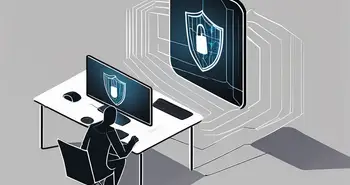Eclipse Attacks Uncovered: The Ultimate Defense Guide

As a cybersecurity expert, I have encountered numerous cyber threats throughout my career. While some attacks are easier to detect and defend against, others like an Eclipse Attack require a deeper understanding and proactive defense strategies. In this ultimate guide, I will explain the basics of an Eclipse Attack, highlight its potential impact, and provide you with practical steps to defend against it.
Understanding an Eclipse Attack
An Eclipse Attack is a sophisticated method used by malicious actors to isolate a target's connection to the outside world. It involves surrounding the victim's network with a cloud of attacker-controlled nodes, effectively blocking all legitimate traffic from reaching the target. This type of attack can have disastrous consequences, including unauthorized access, information theft, and even the manipulation of critical systems.
One of the key aspects of an Eclipse Attack is the stealth with which it can be executed. By strategically positioning compromised nodes around the victim's network, the attacker can create a virtual barrier that goes unnoticed until it's too late. This clandestine approach allows the attacker to maintain control over the victim's network for an extended period, increasing the likelihood of achieving their malicious objectives.
The Basics of an Eclipse Attack
In an Eclipse Attack, the attacker identifies and infiltrates vulnerable nodes within a network. These compromised nodes are strategically positioned around the target, forming a wall that obstructs communication with legitimate nodes. By controlling a majority of the accessible nodes, the attacker gains control over the victim's network and can manipulate incoming and outgoing traffic at will.
Furthermore, the attacker may employ various techniques to ensure the success of the Eclipse Attack. This could include the use of spoofed IP addresses, DNS manipulation, or even leveraging social engineering tactics to gain access to critical network infrastructure. By combining technical expertise with social manipulation, attackers can increase the effectiveness and impact of their Eclipse Attack.
How an Eclipse Attack Works
During an Eclipse Attack, the attacker exploits vulnerabilities in the Border Gateway Protocol (BGP) – the protocol responsible for routing internet traffic. By broadcasting false BGP announcements, the attacker convinces routers and network devices to reroute traffic through their malicious nodes. This rerouting effectively isolates the victim's network and allows the attacker to intercept, modify, or block the targeted communication.
Moreover, the attacker may also deploy additional tactics such as Distributed Denial of Service (DDoS) attacks in conjunction with the Eclipse Attack to overwhelm the victim's network defenses. This multi-pronged approach can create chaos and confusion within the targeted network, making it even more challenging for defenders to identify and mitigate the attack in real-time.
The Potential Impact of an Eclipse Attack
Understanding the potential risks associated with an Eclipse Attack can motivate organizations to take proactive measures to defend against it. Let's explore the potential consequences that can arise from a successful attack.
An Eclipse Attack is a sophisticated form of cyber attack where an attacker can manipulate the victim's network communication by controlling the information exchanged between legitimate nodes. This type of attack can have devastating effects on the targeted entity, leading to a multitude of risks and consequences that can cripple its operations and reputation.
Risks Associated with an Eclipse Attack
An Eclipse Attack poses significant risks to businesses, governments, and individuals. Some of the key risks include:
- Unauthorized access to sensitive data
- Loss of control over critical systems
- Disruption of services and operations
- Damage to reputation and customer trust
- Financial losses resulting from downtime and recovery efforts
Moreover, an Eclipse Attack can lead to regulatory non-compliance, legal repercussions, and potential lawsuits, further exacerbating the impact on the victim organization. The attack vector's stealthy nature can make it challenging to detect and mitigate, allowing the attacker to maintain prolonged access to the compromised network.
The Consequences of a Successful Attack
If an Eclipse Attack is successful, the attacker can exploit the compromised network for various nefarious activities. They may gain unauthorized access to confidential information, redirect communication to malicious servers, or launch additional attacks from within the victim's network. The consequences can be wide-ranging and long-lasting.
Furthermore, the aftermath of a successful Eclipse Attack can include significant financial repercussions due to the costs associated with incident response, system restoration, and potential regulatory fines. The trust and confidence of customers, partners, and stakeholders may also be severely impacted, leading to a loss of business opportunities and credibility in the market.
Preparing Your Defense Against an Eclipse Attack
Defending against an Eclipse Attack requires a proactive approach and a robust security infrastructure. Here are some essential tools and steps to consider:
Essential Tools for Defense
To protect your network from an Eclipse Attack, it is crucial to implement the following tools:
- Intrusion Detection Systems (IDS): Deploy IDS solutions to detect and alert you about any suspicious network activities.
- Intrusion Prevention Systems (IPS): Utilize IPS solutions to proactively block and mitigate potential attacks.
- Firewalls: Employ firewalls to filter and monitor incoming and outgoing network traffic.
- Network Segmentation: Divide your network into isolated segments, limiting the impact of an Eclipse Attack.
Building a Strong Security Infrastructure
In addition to implementing security tools, it is essential to build a robust security infrastructure. This includes:
- Regularly updating and patching software and hardware to address vulnerabilities.
- Developing and enforcing a comprehensive password policy to prevent unauthorized access.
- Conducting thorough security audits and vulnerability assessments to identify weak points.
As an expert, I highly recommend engaging the expertise of a trusted cybersecurity partner. Their knowledge and experience can provide valuable insights and guidance to fortify your defense against Eclipse Attacks.
Strategies for Defending Against an Eclipse Attack
Now that you understand the risks and have laid the foundation for a strong defense, let's explore practical strategies to protect your network from an Eclipse Attack.
Best Practices for Defense
Implement these best practices to bolster your defense against an Eclipse Attack:
- Educate your team about the risks and signs of an Eclipse Attack to ensure vigilance.
- Regularly monitor network traffic for any suspicious patterns or connections.
- Implement strong network access controls and enforce stringent authentication protocols.
- Stay updated with the latest security patches and software updates to address any vulnerabilities.
Advanced Defense Techniques
For organizations with a higher risk profile, adopting advanced defense techniques can provide an additional layer of protection against an Eclipse Attack:
- Utilize encrypted communication protocols to secure data in transit.
- Implement multi-factor authentication to strengthen user access controls.
- Deploy real-time threat intelligence systems to identify and respond to emerging threats.
- Conduct regular penetration testing to assess and address any potential weaknesses in your network.
Maintaining Your Defense Over Time
Defending against an Eclipse Attack is an ongoing effort. Here are two critical steps to maintain a strong defense.
Regular System Checks and Updates
Regularly conduct system checks and updates to ensure your defense remains effective. This includes:
- Performing vulnerability assessments to identify and remediate potential security gaps.
- Keeping security tools, software, and firmware up to date to address evolving threats.
- Monitoring and reviewing system logs to identify any suspicious activities.
Staying Informed About New Threats
As an expert, I strongly recommend staying informed about new threats and emerging attack techniques. This involves:
- Continuously monitoring threat intelligence sources for the latest industry trends.
- Participating in cybersecurity communities and forums to learn from peers and share knowledge.
- Engaging in regular training and certifications to stay up to date with evolving security practices.
Remember, defending against an Eclipse Attack requires a proactive and multidimensional approach. By staying informed, employing the right tools, and integrating effective defense strategies, you can significantly reduce the likelihood of falling victim to this insidious threat.
Frequently Asked Questions (FAQ)
What is an Eclipse Attack?
An Eclipse Attack is a method used by malicious actors to isolate a target's connection to the outside world. By surrounding the victim's network with attacker-controlled nodes, the attacker effectively blocks all legitimate traffic from reaching the target.
What are the risks of an Eclipse Attack?
An Eclipse Attack poses significant risks, including unauthorized access to sensitive data, loss of control over critical systems, disruption of services and operations, damage to reputation and customer trust, and financial losses resulting from downtime and recovery efforts.
How can I defend against an Eclipse Attack?
To defend against an Eclipse Attack, it is crucial to implement essential tools such as intrusion detection systems, intrusion prevention systems, and firewalls. Building a strong security infrastructure by regularly updating software and hardware, developing and enforcing a comprehensive password policy, and conducting security audits is also essential.
By following best practices such as educating your team, monitoring network traffic, implementing strong access controls, and staying updated with security patches, you can strengthen your defense against an Eclipse Attack. For organizations with a higher risk profile, adopting advanced defense techniques such as encrypted communication protocols and multi-factor authentication can provide additional protection.
What steps should I take to maintain my defense over time?
To maintain a strong defense over time, regularly conduct system checks, vulnerability assessments, and updates. Monitor and review system logs to identify any suspicious activities. Stay informed about new threats and emerging attack techniques by monitoring threat intelligence sources, participating in cybersecurity communities, and engaging in regular training and certifications.
Remember, defending against an Eclipse Attack is an ongoing effort that requires continuous monitoring, updating, and staying informed about the evolving threat landscape.
As you fortify your defenses against Eclipse Attacks and other cyber threats, it's equally important to ensure your investments are secure and thriving. Morpher.com offers a revolutionary trading platform that empowers you to trade with zero fees, infinite liquidity, and the safety of a non-custodial wallet. Embrace the future of investing with fractional shares, short selling, and up to 10x leverage to maximize your trading potential. Experience the unique advantages of blockchain-based trading across a wide range of markets. Sign Up and Get Your Free Sign Up Bonus today, and join the community of traders who are reshaping the world of investing with Morpher.

Disclaimer: All investments involve risk, and the past performance of a security, industry, sector, market, financial product, trading strategy, or individual’s trading does not guarantee future results or returns. Investors are fully responsible for any investment decisions they make. Such decisions should be based solely on an evaluation of their financial circumstances, investment objectives, risk tolerance, and liquidity needs. This post does not constitute investment advice.

Painless trading for everyone
Hundreds of markets all in one place - Apple, Bitcoin, Gold, Watches, NFTs, Sneakers and so much more.

Painless trading for everyone
Hundreds of markets all in one place - Apple, Bitcoin, Gold, Watches, NFTs, Sneakers and so much more.









